

Marine Art or ship paintings are a broad niche in the world of painting and sculpture. Many themes, ideas, emotions and periods are beautifully portrayed in such paintings, depicting ships engaged in battle, merchant vessels gliding over the horizon, exploration vessels of the bygone times, ships of powerful generals and pirates and so on.
Most of the world’s famous ship paintings date back to the Age of Exploration and the Age of Conquest, from the 16th to the 18th centuries. These were the times when rapid advancements in maritime technology brought about a revolution in shipping. Many new maritime vessels were being constructed to fulfil the needs of powerful naval states like Portugal, Spain and later the British Empire.
Ships of this era played a vital role in propelling these mercantilist economies and allowed trade between the European continent, the Americas and South East Asia. That may be why ship paintings intrigue art lovers and history enthusiasts alike.
In this article, let us look at the world’s ten famous ship paintings.
One of the most renowned paintings by the English painter and artist Joseph Mallord William Turner, it depicts the last voyage of the Admiralty’s premier vessel 90-gun HMS Temeraire as it was being taken from the Thames River to Rotherhithe in London for being scrapped.
The 1838 oil-on-canvas painting received great attention from art lovers and audiences for its symbolism and vivid play of colours. Painted in the era of Romanticism, it also portrayed the coming of the age of steamships.
The veteran vessel was once dreaded by the enemy states and played a pivotal role in the 1805 Battle of Trafalgar, fought between the British Royal Navy and the combined fleets of the Spanish and French Navies.


However, by 1838 the warship was more than 40 years old and was sold off to a private company, evident in the painting, as the ship carries a white flag instead of the union flag. The Royal Academy exhibited it in 1839, along with a line adapted by Turner from Thomas Campbell’s poem. It said, ‘Ye Mariners of England: The Flag which brave the battle and the breeze, No longer owns her’.
There is a disagreement among people regarding whether Turner saw it being tugged or recreated the scene from his imagination. Nonetheless, he has aptly portrayed the glorious old warship, once the pride of the British Naval fleet.
In 2020, it was printed on the new £20 banknote, while the original can be admired in the National Gallery of London.
The 1633 oil painting by Dutch Baroque artist Rembrandt Van Rijn is one of the greatest art thefts in the world. The serene work depicts the biblical event of Jesus calming the storm on this sea, as described in the holy book. It is the painter’s only seascape painting. However, it was stolen in 1990 from the Isabella Stewart Gardner Museum in Boston.
The painting remains missing, and the mystery behind its theft remains unsolved. However, it has been in the news quite a few times.
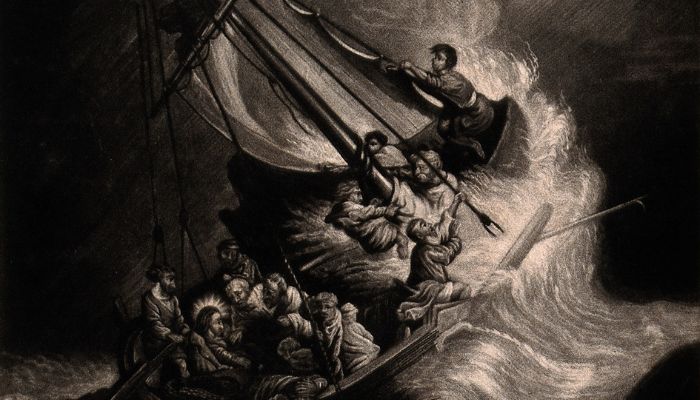

It shows Jesus sitting peacefully while his disciples are trying to remain composed in the face of a heavy storm that has engulfed their boat. While they are tense, they try to hide their concerns and solely rely on Jesus to help them face the crisis.
While the painting is not very exciting or dramatic, it gives a spiritual feel to many. The emotions and feelings of the disciples have been beautifully portrayed by Rembrandt.
The eighteenth century was the era of ship paintings, usually commissioned by wealthy patrons like Merchants apart from Royals. However, sometimes the artists also depicted some famous ships in their artworks. One such masterpiece was painted by George Philip Reinagle, known for his mesmerising sea paintings.
Unlike other artists, who focussed on the vessel, he highlighted the ever-changing character of the seas, the power and the might of waves that tore apart many famous ships.
His 1836 painting is true to its name as it shows a vessel caught in the clutches of a raging and tumultuous sea.
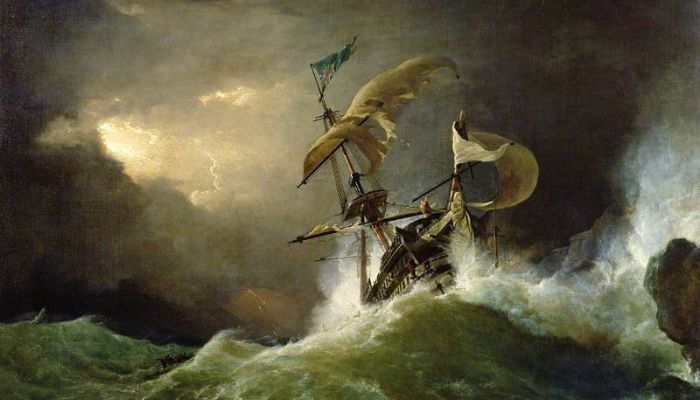

It also highlights one of the most dangerous aspects of marine travel: the possibility of death if the seamen were caught in a terrible storm, also called a gale.
This work is iconic as it depicts an almost realistic scene as if it were happening in front of one’s eyes. It also lets one imagine how many lives must have been taken by the high seas during those times.
Most ship paintings depict vessels engaged in naval wars or caught between the powerful waves on the high seas. However, very few portray the calm and serene nature of the seas.
One such work is the 1860 painting by Fitz Hugh Lane that beautifully captures a scene that people outside of the maritime world can never experience. It portrays a vessel close to Halfway Rock, a popular marker between Boston and Cape Ann.
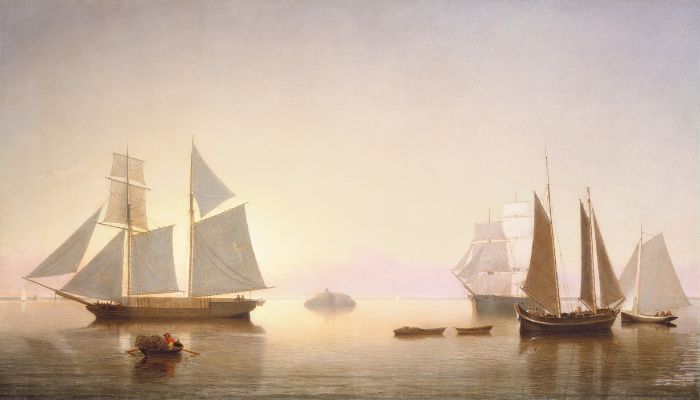

It was a famous halting point for merchant vessels and supply ships. They could catch up with other boats and also promote their business at this point, while it also allowed the sailors to relax and rejuvenate themselves on land.
The painting shows two big ships anchored and three boats moving from one point to another as if dealing with cargo items being carried in the big ships. This painting is currently in the National Gallery, Washington.
A Fair Wind/Breezing Up, painted by Winslow Homer between 1873-76, shows a catboat with three young lads and a man. It is one of the most iconic paintings in the US. It has excellent symbolism and portrays harsh waves, yet the people on the boat look calm and in control of the situation.
Hence, a certain kind of optimism is evident in the work, and though it is not a large painting, it truly reflects the spirit of American life in those days. The anchor in the bow of the vessel is interpreted as symbolising hope for the bright future of the newly formed United States.


The painting portrays the growing influence of Japanese styles of art on European painters in the 19th century. Homer had been to France to get inspiration for his paintings from his contemporaries like Gustave Courbet and Claude Monet. The painting was completed in 1876 and showcased many influences of the time.
Jan Van de Cappelle was one of the most famous painters who aptly captured the essence of marine travel and the vivid emotions associated with it in his works. He did not paint harsh seas or cloudless skies but showed vessels and clouds over the horizon.
In the 16th and 17th centuries, marine travel or seafaring gained prominence, and many seemed to make great fortunes through it. It also modelled communities and newly emerging nation-states. Also, many cultural exchanges between people and diverse religious and ethnic groups were made possible by sea voyages of exploration.


Dutch painter Cappelle was known for his seascapes or river views with many ships in sight. In this particular work, we can see a row of vessels anchored while two yachts fire a salute for the sailors or officials sailing by in a state-owned barge. The water is calm and almost crystal-clear as it reflects the passengers’ and the vessel’s image.
The 1650 painting depicting some ships anchored in port, saluting a vessel going on its voyage, depicts how popular sea travel had become, for many reasons, in this case for the Dutch Empire.
The painting was executed by Simon de Vlieger sometime around 1640-45. Born in Rotterdam in 1601, Vlieger’s ‘Seascape in the morning’ tells the story of deliverance after travail. The artist portrays this through the hues of the sky.
On the right of the painting, the sky is dark, and one can see a sailor or seaman on a damaged boat. A fire can be seen, a boat rowing to the shore and some vessels are waiting in the distance. A figure of a man is standing; whether for thanksgiving or deliverance, that is unknown.
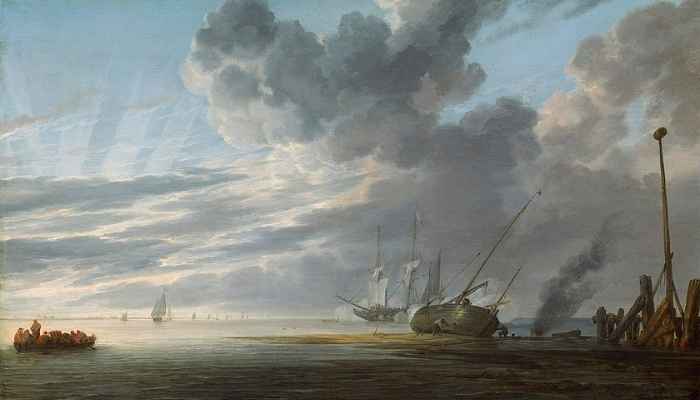

In the middle is a large ship heading towards the horizon and other vessels seem like ghostly apparitions the closer they get to the horizon.
The horizon is portrayed as kind, evident from the white light that comes down from the clouds. It is morning, and it seems the ships have survived a tumultuous sea at night and survived.
Many look at it with great optimism, as if it were a religious painting. It beautifully portrays human sufferings in this world, trials and tribulations and the hope for heaven.
Willem van de Velde II was a Dutch painter admired for his marine paintings, executed in the 17th century. It was a time when vessels marked the height of humankind’s technological breakthroughs, and naval fleets were an intrinsic part of a nation’s military prowess.
His ‘Dutch Men-O’-War and Other Shipping in a Calm’ was painted in 1665 and portrayed the Dutch navy’s enormous fleet of naval ships, including the much feared and dreaded Men-O’-war vessels.
They were known as floating fortresses laden with weapons and could overtake enemy ships, coastal forts, settlements, and cities in no time.


The painting shows many of these ships, laden with captains and crews, portraying the naval power of the Dutch.
Although the term ‘Men-O-War never acquired a specific meaning, it was used for a vessel with cannons and usually sails, as opposed to a galley with oars.
One of J.M.W Turner’s most recognised and acclaimed works, ‘The Slave Ship’ is a beautiful yet deeply saddening work depicting the harsh realities of the time. At a glance, the painting seems ordinary, showing a seafaring ship caught in a storm. Its thin masts indicate that the vessel could sink at any time, while the red and black used for the sky convey the sense of foreboding and demise.
It is an unfortunate vessel, and the scene depicted in the painting is hear-wrenching. One of the slave men has a manacled ankle, and looking at the work, one can gauge that the victims onboard the vessels are slaves trapped in a sinking ship. While the scene is blurred, Turner uses strong and bright colours and sharp brushstrokes to portray the feelings behind the painting.
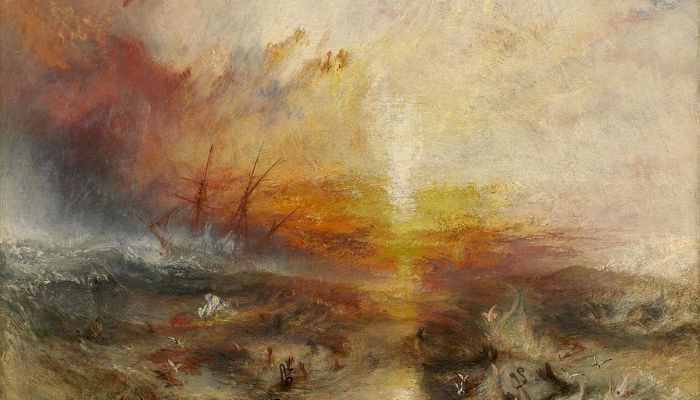

Such happenings were not uncommon. During those times, ships sailing with slaves were sometimes deliberately sunk in case disease spread among the slaves. While it is cruelty at its peak, such incidents reflected the norms of those times.
Turner took inspiration from events like the Zhong Massacre, wherein the crew of the slave ship threw 54 female slaves and several children from the portholes, along with many protestors.
The enchanting ‘Fishing Boats on the Beach at Saints-Maries’ is one of the many paintings made by Van Gogh in 1888, when he travelled to Saintes-Maries-de-la-Mer on the Mediterranean Sea. During those times, Saintes-Maries was a fishing village inhabited by less than 100 families.
He used a reed pen to make the boats, and his strokes and technique highlight the influence of Japanese prints on him. The seaside scene captures the everyday life of the people living in the region, and the painting depicts harmony and balance. Although he was ill, the seascapes painted by him were like a ray of hope to enjoy the things he loved before he passed away.
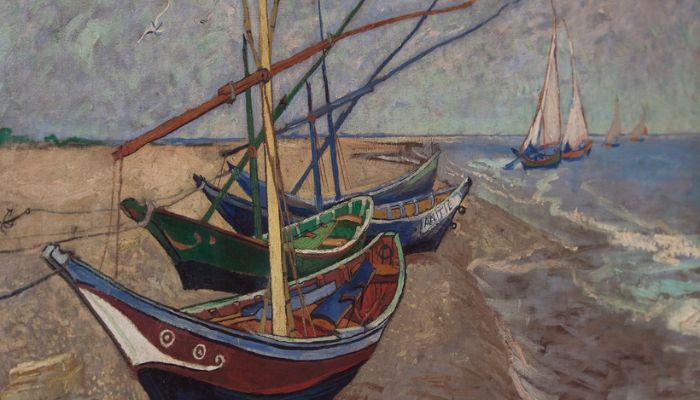

He made use of a palette knife to apply colours. The white and blue regions of the sea are superimposed with green and blue to make waves. This gives it a realistic look and makes it look surreal and charming.
You might also like to read-
Disclaimer: The authors’ views expressed in this article do not necessarily reflect the views of The Marine Learners. Data and charts, if used, in the article have been sourced from available information and have not been authenticated by any statutory authority. The author and The Marine Learners do not claim it to be accurate nor accept any responsibility for the same. The views constitute only the opinions and do not constitute any guidelines or recommendations on any course of action to be followed by the reader.
The article or images cannot be reproduced, copied, shared, or used in any form without the permission of the author and The Marine Learners.










We believe that knowledge is power, and we’re committed to empowering our readers with the information and resources they need to succeed in the merchant navy industry.
Whether you’re looking for advice on career planning, news and analysis, or just want to connect with other aspiring merchant navy applicants, The Marine Learners is the place to be.